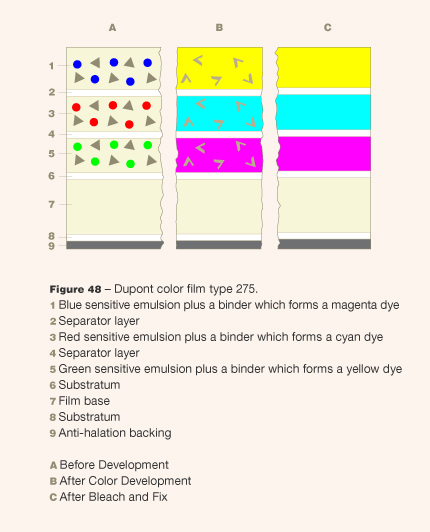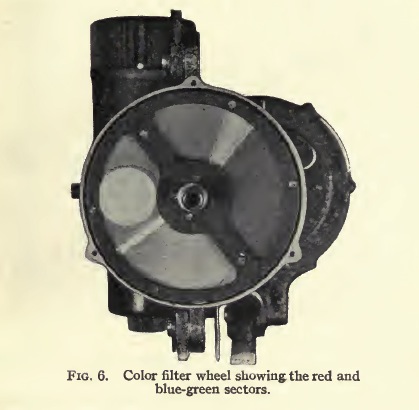Select Category▼×
- All Categories
- Bibliography
- Chromogenic monopack
- Chromolytic multilayer
- Color separation
- Double-coated / bi-pack
- Edge Codes and Identification
- Hand coloring
- Other
- Printing / dye-transfer
- Printing / pigment process
- Screen processes
- Spatial synthesis (multiple lenses, beam splitter)
- Stencil coloring (pochoir, Pathécolor)
- Temporal synthesis (rotary filters)
- Theory
- Tinting
- Toning
-
![]() cross section scheme of Ektachrome Type 5257 (and 5258). Scource: Groet, N.H./Murray, T.J./Osborne, C.E. (1960): Two High-Speed Color Films and a Reversal Print Film for Motion Picture Use. In: JSMPTE Vol. 69, p. 816.
cross section scheme of Ektachrome Type 5257 (and 5258). Scource: Groet, N.H./Murray, T.J./Osborne, C.E. (1960): Two High-Speed Color Films and a Reversal Print Film for Motion Picture Use. In: JSMPTE Vol. 69, p. 816.
1 Image
Although Kodachrome 16mm reversal film was introduced as an amateur film format, rapidly after its introduction it became a format frequently used by (semi-)professional film makers. The reason was that Kodachrome was a relatively easy to use film ...
Duplicating stock for reversal film. Replaced Kodachrome duplicating stock type 5262. Contrary to its predecessor the new stock was not suited as camera material. Type 5265 could only be used for duplication.
Kodachrome Professional was introduced in 1942 to be used as camera material. It was the Kodachrome material that was blown up to 35mm Technicolor dye transfer prints, which was the Technicolor Monopack system.
According to Norris Pope this material ...
In 1946 Kodachrome Commercial camera film Type 5268 was introduced. This stock had a lower-contrast emulsion and became leading in the professional field until it was replaced by Ektachrome Commercial type 7255 in 1958. Both Commercial Kodachrome and ...
Kodachrome II was introduced in 1961. It was the first film stock since 1936 that was specifically meant for amateur use. Eastman Kodak presented the material as superior to the ‘regular Kodachrome’. It supposedly had a higher speed of 25 ...
-
![]() La perception et l'imaginaire (FRA 1964, Éric Duvivier). Credit: Image'Est. Photographs of the Kodachrome II camera material by Bregt Lameris, ERC Advanced Grant FilmColors.
La perception et l'imaginaire (FRA 1964, Éric Duvivier). Credit: Image'Est. Photographs of the Kodachrome II camera material by Bregt Lameris, ERC Advanced Grant FilmColors.
- Les autopathes (FRA 1971, Éric Duvivier). Credit: Image'Est. Photographs of the kodachrome reversal by Bregt Lameris, ERC Advanced Grant FilmColors.
- Hallucinations: Images du monde visionnaire (FRA 1963, Éric Duvivier). Credit: Image'Est. Photographs of undated Kodachrome II projection print by Bregt Lameris, ERC Advanced Grant FilmColors.
84 Images in 5 Galleries
-
![]() Credit: Illustration by Sarah Steinbacher, Multimedia & E-Learning-Services, University of Zurich. Source: Ryan, Roderick T. (1977): A History of Motion Picture Color Technology. London: Focal Press.
Credit: Illustration by Sarah Steinbacher, Multimedia & E-Learning-Services, University of Zurich. Source: Ryan, Roderick T. (1977): A History of Motion Picture Color Technology. London: Focal Press.
- Source: Ryan, Roderick T. (1977): A History of Motion Picture Color Technology. London: Focal Press.
- Source: Sease, V. B. (1949): DuPont's New Color Film. In:American Cinematographer, 30: 240, 257-258.
- Credit: Illustration by Sarah Steinbacher, Multimedia & E-Learning-Services, University of Zurich. Source: Sease, V. B. (1949): DuPont's New Color Film. In:American Cinematographer, 30: 240, 257-258.
8 Images in 1 Gallery
“An American two-colour subtractive process still worked by the Consolidated Film Industries division of Republic Pictures Corporation. This concern was licensed by the owners of the “Prizma” patents, which it will be remembered was ...
-
![]() Mysore Yesterday and Tomorrow Credit: Image courtesy of the 20th Century Fox Collection at the Academy Film Archive. Photograph: Barbara Flueckiger.
Mysore Yesterday and Tomorrow Credit: Image courtesy of the 20th Century Fox Collection at the Academy Film Archive. Photograph: Barbara Flueckiger.
23 Images in 2 Galleries
“By the 1940s, most of the two-colour subtractive processes, apart from Cinecolor, were obsolete. The widespread use of the high-quality Technicolor process showed up the serious deficiencies in the simpler methods. The only significant new ...
-
![]() Russian Ideas in Clothes! (USA 1922). Credit: UCLA Film & Television Archive. Photographs of the nitrate print by Barbara Flueckiger.
Russian Ideas in Clothes! (USA 1922). Credit: UCLA Film & Television Archive. Photographs of the nitrate print by Barbara Flueckiger.
21 Images in 1 Gallery
-
![]() Credit: Geo. Willeman, Nitrate Film Vault Manager, Library of Congress.
Credit: Geo. Willeman, Nitrate Film Vault Manager, Library of Congress.
- Credit: Geo. Willeman, Nitrate Film Vault Manager, Library of Congress.
2 Images
-
![]() Source: Dubray, J.A. (1933): The Morgana Process In: Journal of the Society of Motion Picture Engineers 21,5, 1933, pp. 403-412.
Source: Dubray, J.A. (1933): The Morgana Process In: Journal of the Society of Motion Picture Engineers 21,5, 1933, pp. 403-412.
1 Image
-
![]() Ansco Color, positives of Ansco Color negative, ca. 1952. Credit: Gert Koshofer Collection. Sample No. 10. Photograph by Barbara Flueckiger.
Ansco Color, positives of Ansco Color negative, ca. 1952. Credit: Gert Koshofer Collection. Sample No. 10. Photograph by Barbara Flueckiger.
- Source: Schultze, Werner (1953): Farbenphotographie und Farbenfilm. Wissenschaftliche Grundlagen und technische Gestaltung. Berlin/Göttingen /Heidelberg: Springer.
- Source: Schultze, Werner (1953): Farbenphotographie und Farbenfilm. Wissenschaftliche Grundlagen und technische Gestaltung. Berlin/Göttingen /Heidelberg: Springer.
- Source: Society of Motion Picture and Television Engineers; ed. (1957): The Elements of Color in Professional Motion Pictures. Prepared by a special committee of the Society. Wilton R. Holm, chairman. New York: The Society.
- Credit: Cinémathèque française, conservatoire des techniques, Paris.
- Source: Schultze, Werner (1953): Farbenphotographie und Farbenfilm. Wissenschaftliche Grundlagen und technische Gestaltung. Berlin/Göttingen /Heidelberg: Springer-Verlag. Photograph by Martin Weiss, ERC Advanced Grant FilmColors.
- Source: Schultze, Werner (1953): Farbenphotographie und Farbenfilm. Wissenschaftliche Grundlagen und technische Gestaltung. Berlin/Göttingen /Heidelberg: Springer-Verlag. Photograph by Martin Weiss, ERC Advanced Grant FilmColors.
30 Images in 2 Galleries
-
![]() Cross section scheme of Anscochrome. Scource: Forrest; John L. (1955): Processing Anscochrome Motion-Picture Films for Industrial and Scientific Applications. In: Journal SMPTE, Vol. 64, Dec. 1955, p. 679.
Cross section scheme of Anscochrome. Scource: Forrest; John L. (1955): Processing Anscochrome Motion-Picture Films for Industrial and Scientific Applications. In: Journal SMPTE, Vol. 64, Dec. 1955, p. 679.











